Namche Bazaar is a vibrant Sherpa village in the Himalayas. Enjoy its rich culture, stunning scenery, and must-visit spots on the path to Everest.
Nestled high in the majestic Himalayas, Namche Bazaar introduces itself like a gem amidst towering peaks and green valleys. The first sight of this charming village, situated at 3,440 meters, is nothing short of enchanting. Colorful houses cascade down the terraced hillside, their vibrant hues contrasting against the stark backdrop of snow-capped mountains. The crisp, thin air is filled with the distant tinkling of yak bells and the hum of bustling activity from the local market.
I have journeyed to Namche Bazaar many times, trekking through the rugged trails of the Everest region. Each visit unveils new layers of this remarkable place. From its warm-hearted Sherpa people to its rich cultural tapestry, Namche Bazaar is far more than a mere stopover for trekkers. It is a vibrant community with a unique spirit, steeped in tradition and brimming with stories waiting to be told.
Namche Bazaar, often referred to simply as Namche, has a history as rich and colorful as the surrounding landscapes. Originally a modest trading post, Namche evolved into a vital commercial center, connecting the Sherpa people with traders from Tibet. The bustling market, known locally as bazaar, was where goods like salt, wool, and grains were bartered, fostering a thriving economy long before the advent of tourism.
The village’s strategic location made it an essential stop for expeditions to Mount Everest. As the gateway to the Everest region, Namche became a melting pot of cultures and a hub for mountaineers from around the globe. Sir Edmund Hillary and Tenzing Norgay, who famously summited Everest in 1953, passed through Namche, cementing its status in the annals of mountaineering history.
Namche Bazaar Map
Today, Namche Bazaar remains a critical acclimatization stop for trekkers and climbers en route to Everest Base Camp. But beyond its logistical importance, Namche stands as a testament to the enduring spirit of the Sherpa people, who have transformed it into a thriving community while preserving its rich cultural heritage.
The Sherpas Of Namche
Namche Bazaar is home to the Sherpas, renowned for their mountaineering skills and warm hospitality. Originally from Tibet, the Sherpa community settled in the Everest region centuries ago. They are known for their resilience, strength, and deep connection to the mountains. Their culture is woven with threads of Buddhist beliefs, strong family ties, and a harmonious relationship with nature.
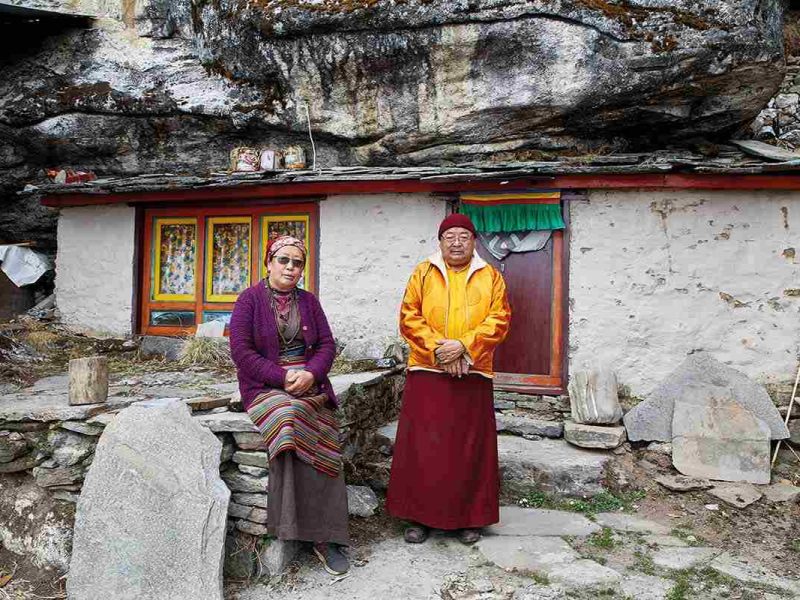
Life in Namche revolves around communal activities. Karma Sherpa, a local lodge owner, starts his day before dawn, offering prayers at the nearby Chorten (a Buddhist shrine) before preparing breakfast for trekkers. The sound of chanting monks from the Namche Monastery fills the morning air, blending with the buzz of traders setting up their stalls at the weekly market.
While the Sherpas form the core of Namche’s population, other ethnic groups like the Tamang and Rai also reside here, contributing to the village’s cultural diversity. Each group brings its unique traditions, adding to the rich tapestry of Namche’s social fabric.
Cultural Richness Of Namche Bazaar
Religion is at the heart of life in Namche Bazaar. The predominant practice is Tibetan Buddhism, evident in the many monasteries and prayer wheels that dot the village. One of the most revered sites is the Tengboche Monastery, a spiritual haven located a few hours from Namche. It stands as a beacon of serenity, with monks clad in maroon robes performing daily rituals amidst the backdrop of the Himalayas.
Local customs and rituals are vibrant and deeply rooted in tradition. Festivals like Mani Rimdu, celebrated with masked dances and elaborate ceremonies, showcase the rich cultural heritage of the Sherpa people. During these times, villagers gather at the monastery, wearing traditional attire and sharing tsampa (roasted barley flour) and butter tea.
Namche Bazaar is also a treasure trove of folklore and legends. Stories of Yeti, the elusive snowman, are whispered among the elders. According to local lore, these mythical creatures dwell in the remote corners of the Himalayas, guarding the sacred peaks. Such tales add an air of mystique to the already enchanting landscape.
Must Visit Places In Namche
Namche Bazaar boasts several sites of cultural and historical significance. The Tengboche Monastery is a must-visit. Perched at an altitude of 3,867 meters, it offers breathtaking views of Everest, Ama Dablam, and other towering peaks. The monastery, founded in 1916, is a center for Tibetan Buddhist learning and practice, attracting pilgrims and visitors from around the world.
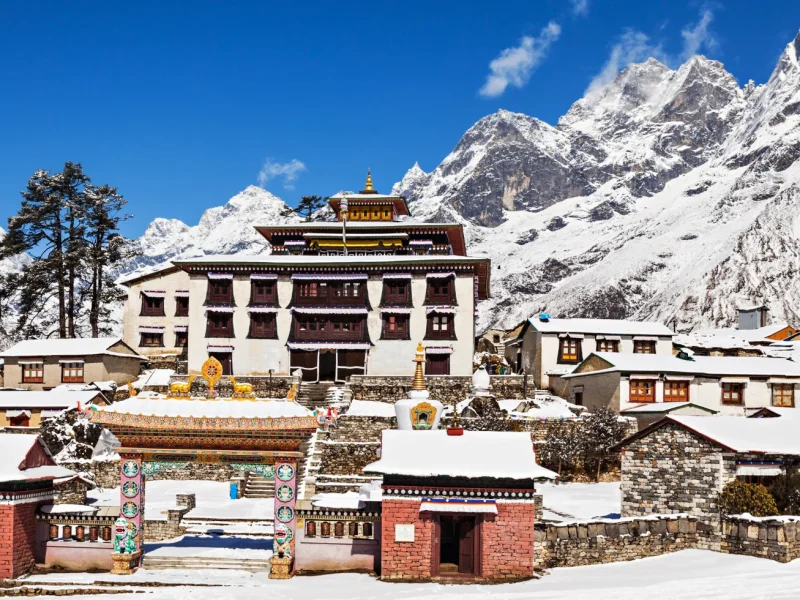
The Sherpa Culture Museum provides a deep dive into the history and traditions of the Sherpa people. Exhibits include mountaineering artifacts, traditional clothing, and photographs chronicling the lives of the early Everest pioneers. A visit here offers a profound appreciation of the Sherpas’ contribution to Himalayan exploration.
Markets in Namche Bazaar are a sensory delight. Every Saturday, the village transforms into a bustling bazaar where traders from surrounding areas come to sell their goods. From fresh produce and handcrafted items to trekking gear, the market is a vibrant hub of activity. It’s an excellent place to experience the local way of life and perhaps even pick up a unique souvenir or two.
Top 5 Must-Visit Spots In Namche Bazaar
- Tengboche Monastery: Perched atop a hill overlooking Namche Bazaar, the Tengboche Monastery is a spiritual sanctuary offering panoramic views of the Himalayas. Visitors can witness daily rituals performed by resident monks and soak in the serene ambiance of this sacred site.
- Everest View Hotel: For breathtaking vistas of Mount Everest and its neighboring peaks, a visit to the Everest View Hotel is a must. Situated above Namche Bazaar, this luxury hotel offers unparalleled views of the world’s highest mountain, making it an ideal spot for sunrise or sunset viewing2.
- Namche Market: Immerse yourself in the vibrant atmosphere of Namche’s weekly market, held every Saturday. From fresh produce to handcrafted souvenirs, the market offers a glimpse into the local way of life. Don’t forget to haggle with the friendly vendors for the best deals.
- Sherpa Culture Museum: Delve into the rich history and heritage of the Sherpa people at the Sherpa Culture Museum. Located in the heart of Namche Bazaar, this museum features exhibits on Sherpa mountaineering history, traditional clothing, and cultural artifacts, providing valuable insights into Sherpa culture and lifestyle.
- Khumbu Gallery: Explore the Khumbu Gallery, a showcase of stunning photography capturing the beauty and adventure of the Everest region. From towering peaks to vibrant landscapes, the gallery offers a visual journey through the mesmerizing landscapes of the Himalayas5.
A Delight For Flora And Fauna Explorers
Namche Bazaar is not just a hub for trekkers; it’s also a haven for nature lovers. The surrounding area boasts a stunning array of flora and fauna. The Sagarmatha National Park, a UNESCO World Heritage Site, is home to some of the world’s most unique biodiversity. Trekking through the park, one might spot the elusive snow leopard or the Himalayan tahr, a wild goat known for its agility on rocky slopes.
The forests around Namche are dense with rhododendron, juniper, and birch trees. During spring, the hillsides burst into color as the rhododendrons bloom in vibrant shades of red, pink, and white. The forests are also alive with birds, including the colorful Danphe, or Himalayan Monal, which is Nepal’s national bird.
Local and international efforts are ongoing to preserve this natural beauty. Organizations like the Sagarmatha Pollution Control Committee work tirelessly to protect the environment from the impact of tourism. These efforts ensure that future generations can enjoy the pristine beauty of Namche and its surroundings.
The Business Of Namche
Namche Bazaar thrives on a mix of tourism, trade, and agriculture. Tourism is the backbone of the local economy. Every year, thousands of trekkers and climbers pass through Namche on their way to Everest. This arrival of visitors supports a wide range of businesses, from lodges and restaurants to gear shops and guiding services.
Trade is another vital aspect of Namche’s economy. The Saturday market is a vibrant scene where traders from nearby villages and even Tibet come to sell their goods. Everything from fresh produce and spices to clothing and household items can be found here. This market is not just a place to buy and sell; it’s a social event where people catch up on the latest news and gossip.
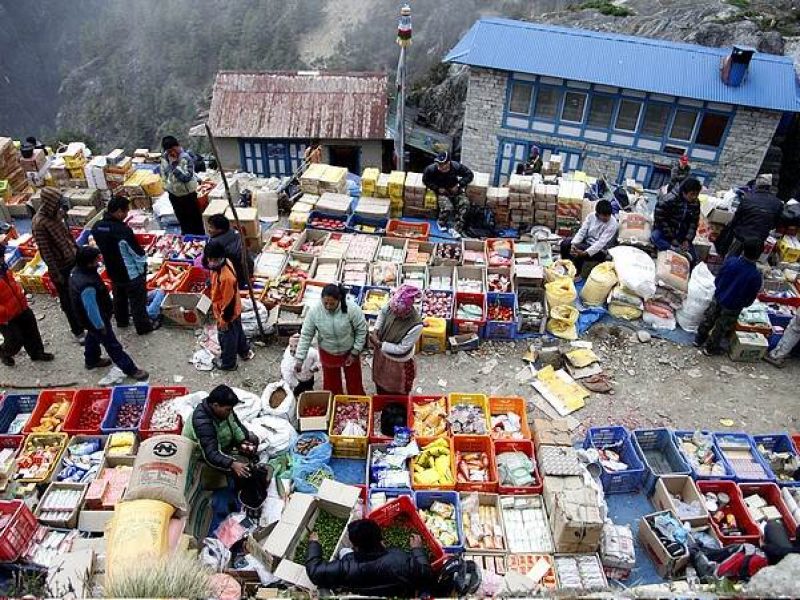
Agriculture, though less prominent, still plays a role in Namche’s economy. Villagers cultivate potatoes, barley, and vegetables on the terraced fields surrounding the village. These crops are not only for local consumption but are also sold to trekkers and climbers.
Local entrepreneurs like Lhakpa Dorji Sherpa, who owns a popular teahouse, have capitalized on the trekking boom. His teahouse offers a cozy retreat for trekkers, with warm beds and hearty meals. Such enterprises are a testament to the resilience and adaptability of the people of Namche.
Namche | Gateway To Everest Region Trekking
Namche Bazaar is known as the Gateway to Everest. From here, trekkers set off on some of the most famous trails in the world. The journey to Everest Base Camp is a challenging yet rewarding trek that offers stunning views of the highest peaks on the planet. Along the way, trekkers pass through picturesque villages, cross suspension bridges, and climb steep trails, all while being surrounded by the breathtaking beauty of the Himalayas.
Other popular treks include the Gokyo Lakes trek, which takes trekkers to a series of turquoise glacial lakes, and the Three Passes trek, which offers a more strenuous route with panoramic views of Everest, Lhotse, and Makalu. Each trek has its unique charm and challenges, making Namche an ideal base for exploring the Everest region.
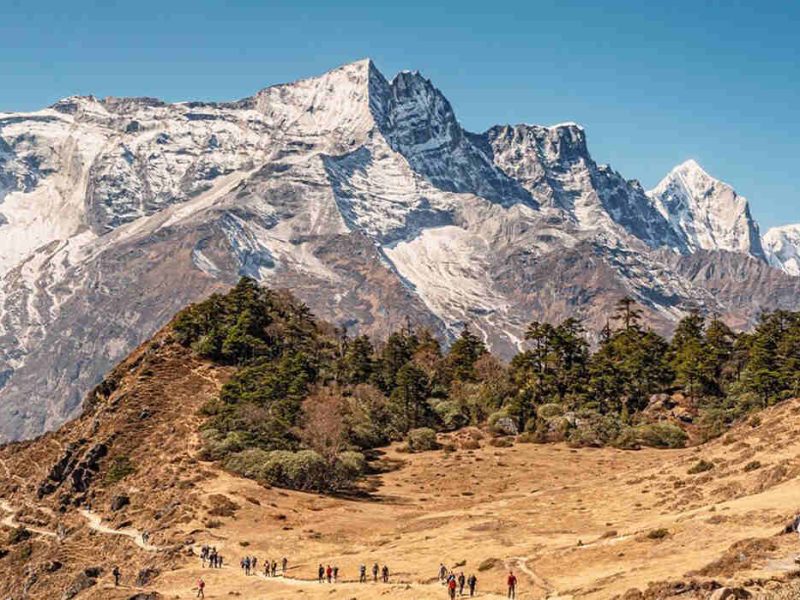
Namche Bazaar is well-equipped to support trekkers. Some numerous teahouses and lodges offer comfortable accommodations and meals. Places like the Everest Bakery are famous for their apple pie and other treats, providing a much-needed morale boost after a long day on the trail.
The village also has several gear shops where trekkers can rent or buy equipment. The presence of reliable guide services ensures that both novice and experienced trekkers can safely navigate the trails. The Himalayan Rescue Association clinic in Pheriche provides medical support, crucial for those suffering from altitude sickness or other ailments.
Popular Everest Region Treks From Namche
| Trekking Packages | Days to Trek | Level of Expertise |
| Everest Base Camp Trek | 12-14 days | Moderate |
| Gokyo Lakes Trek | 12-14 days | Moderate |
| Everest Three Passes Trek | 16-18 days | Challenging |
| Everest Panorama Trek | 7-9 days | Easy to Moderate |
| Everest High Passes Trek | 18-20 days | Challenging |
Practical Information For Travelers
Getting There: Reaching Namche Bazaar is an adventure in itself. Most travelers fly into Tenzing-Hillary Airport in Lukla, often dubbed one of the world’s most dangerous airports1. From Lukla, it’s a scenic trek through picturesque villages and lush forests, taking approximately two days to reach Namche. For those seeking a more leisurely journey, helicopter services are available from Kathmandu to Lukla.
When to Visit: The best times to visit Namche Bazaar are during the spring (March to May) and autumn (September to November) seasons. These months offer clear skies, mild temperatures, and stunning views of the surrounding peaks. Winter brings cold temperatures and occasional snowfall, while the monsoon season (June to August) can make trekking challenging due to heavy rain and landslides.
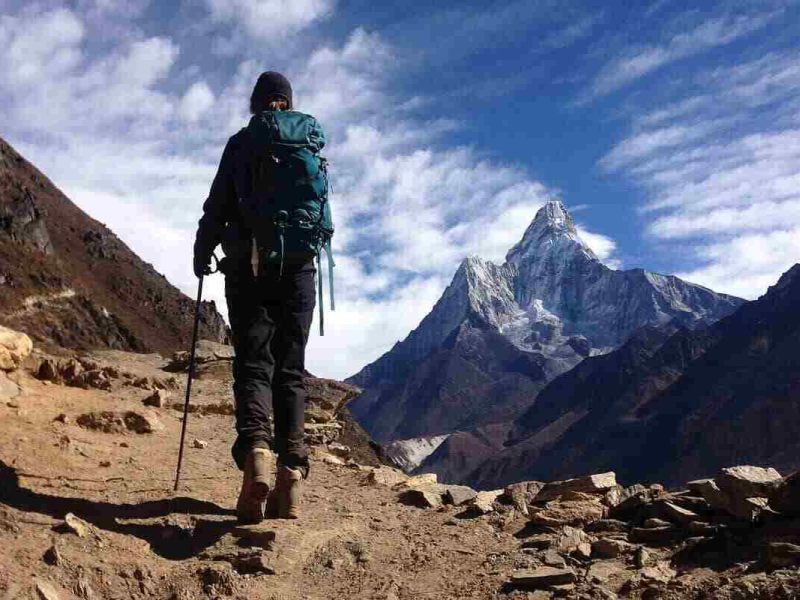
Travel Tips:
- Acclimatization: It’s essential to acclimatize properly to the altitude to avoid altitude sickness. Spend at least two nights in Namche to adjust before continuing your trek.
- Pack Light: Trekking in the Everest region requires carrying a backpack with essentials like water, snacks, warm clothing, and personal items. Keep your pack light to avoid unnecessary strain.
- Respect Local Customs: Namche Bazaar is a culturally rich and religiously significant place. Respect local customs, such as removing shoes before entering monasteries, and ask for permission before taking photographs of people or religious sites.
- Stay Hydrated and Rest: Drink plenty of water to stay hydrated, especially at higher altitudes. Take breaks as needed and listen to your body’s signals.
Quick Guide To Sherpa Cuisine
- Sherpa Stew: A hearty and flavorful stew made with locally sourced ingredients like potatoes, lentils, and yak meat. Perfect for warming up after a day of trekking in the chilly Himalayan air.
- Tsampa: A staple food of the Sherpa people, tsampa is roasted barley flour mixed with butter tea to form a dough-like consistency. It’s often enjoyed as a nutritious and energy-packed snack during treks.
- Sherpa Bread: A delicious bread made from buckwheat flour, Sherpa bread is a favorite among trekkers. It’s dense and filling, making it an ideal snack or accompaniment to meals on the trail.
- Yak Cheese: Sample authentic yak cheese, a specialty of the Everest region. Made from the milk of Himalayan yaks, this cheese has a unique flavor and texture, perfect for cheese lovers looking to indulge in local delicacies.
Essential Gear For Trekking In The Everest Region
- Quality Trekking Boots: Invest in a strong pair of trekking boots with good ankle support and waterproofing to start the rugged terrain of the Everest region.
- Layered Clothing: Pack lightweight, moisture-wicking layers to stay warm and dry in varying weather conditions. Include a down jacket or fleece for extra insulation at higher altitudes.
- Trekking Poles: Reduce strain on your knees and improve stability on uneven terrain with a pair of trekking poles. They’re essential for traversing steep ascents and descents along the trail.
- High-Altitude Medications: Consult with a healthcare professional before your trek to obtain medications for altitude sickness prevention and treatment. Acclimatization is key to a safe and enjoyable trek in the Everest region.
- Headlamp: Ensure you have a reliable headlamp for navigating dark trails during early morning or evening treks. It’s essential for safety and convenience, especially in remote areas with limited lighting.
Questions That Travellers Ask About Namche Bazaar
1. What are the best times of year to visit Namche Bazaar?
The best times to visit Namche are during the spring (March to May) and autumn (September to November) when the weather is mild, and the skies are clear. These seasons offer optimal trekking conditions and stunning views of the surrounding mountains.
2. Is it possible to learn about traditional Sherpa crafts and skills?
Yes, visitors can participate in workshops and demonstrations to learn traditional Sherpa crafts such as thangka painting and hand weaving. Local artisans are often happy to share their skills and knowledge with curious travelers.
3. Can visitors experience a homestay or cultural exchange with local Sherpa families?
Absolutely! Many Sherpa families in the region warmly welcome visitors into their homes, offering authentic homestay experiences and opportunities for cultural exchange. Staying with a Sherpa family provides a unique glimpse into their way of life, traditions, and customs.
Guests can participate in daily activities such as cooking traditional meals, spinning yarn, or even helping out in the fields. It’s a chance to forge meaningful connections, learn about Sherpa culture firsthand, and create lasting memories.
These homestay experiences not only support local families but also enrich the travel experience by fostering genuine cultural exchange.
4. Are there any spiritual retreats or meditation centers?
Yes, in Namche Bazaar and its surrounding areas, there are spiritual retreats and meditation centers where visitors can find solace. One such center is the Khumjung Monastery, which offers meditation retreats and spiritual guidance in the tranquil setting of the mountains.
Another notable retreat center is the Tengboche Monastery, located a short trek from Namche Bazaar. This revered Buddhist monastery hosts meditation retreats and spiritual programs, allowing visitors to deepen their practice.
Participants can join guided meditation sessions, attend teachings by experienced lamas, and witness ancient rituals performed by the resident monks.
5. What peaks are visible from this bazaar?
From Namche Bazaar’s lofty vantage points, trekkers are treated to spellbinding views of towering peaks such as the formidable Thamserku, the majestic Kongde Ri, and the elusive tip of Mount Everest, teasing with its distant presence. The panorama is a feast for the eyes and a testament to the raw, untamed beauty of the Himalayas3.
6. How long is the trek from Lukla to here?
The trek from Lukla to Namche Bazaar spans approximately two days of exhilarating hiking. Day one typically entails a scenic trek to Phakding, followed by a challenging ascent to Namche Bazaar on the second day, covering a distance of roughly 13.5 kilometers (8.3 miles)6.
7. How many days from here to Everest Base Camp?
Embarking on the epic journey from Namche Bazaar to Everest Base Camp typically spans 6 to 8 awe-inspiring days. This timeframe allows trekkers to acclimatize to the high altitude, with essential rest stops at strategic locations such as Dingboche or Lobuche.
8. Is there WIFI in Namche Bazaar?
Yes, many lodges, cozy cafes, and bustling restaurants provide WIFI connectivity, although trekkers should be mindful of the occasional disruptions, particularly during peak trekking seasons.
Footnotes
- Nepal Tourism Board. “Namche Bazaar.” Nepal Tourism Board, https://www.welcomenepal.com/places-to-see/namche-bazaar.html.
- Lonely Planet. “Namche Bazaar.” Lonely Planet, https://www.lonelyplanet.com/nepal/namche-bazaar.

Comment (0)